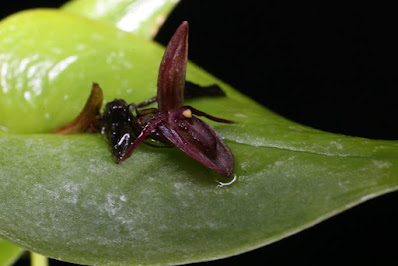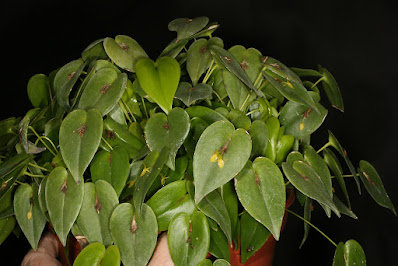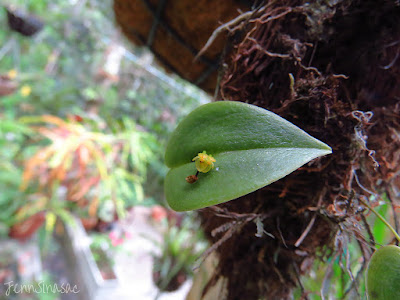Pleurothallis phyllocardioides - Heart-Shaped Leaf Bonnet orchid flowers are variable in color and form. They can be green-yellowish to dark purple.
Pleurothallis phyllocardioides also called as Heart-Shaped Leaf Bonnet orchid, Acronia phyllocardioides, Zosterophyllanthos phyllocardioides, Pleurothallis acostaei, Pleurothallis graciliscapa, Pleurothallis rhaphidopus, is a species of the genus Pleurothallis. This species was described by Friedrich Richard Rudolf Schlechter in 1923.
PLEUROTHALLIS PHYLLOCARDIOIDES - HEART-SHAPED LEAF BONNET ORCHID DESCRIPTION
Pleurothallis phyllocardioides is native to Bolivia, Colombia, Costa Rica, Ecuador, Guatemala, Nicaragua, Panamá, Peru, Venezuela. It is found growing on trees in wet montane forests at elevations of 20 to 1800 meters above sea level.
It is a hot to cool growing, miniature, caespitose epiphyte which reaching up to 10 cm in height with erect, rigid, 9.5 cm long stem that are covered with 2 basal, elongate, tubular sheaths. The single leaf is cordate, apical, ovate, triangular, cordate, acuminate, stiff, slightly coriaceous, to 4.5 cm long and is held perpendicular to the stem.
Heart-Shaped Leaf Bonnet orchid blooms in the fall through the spring, often reblooming off old inflorescence on an apical, short, fasciculate inflorescence that holds the flowers against the base of the leaves. The flowers are variable in both color and form. They can be green-yellowish to dark purple in color, with a yellow-orange anther. Sepals are concave, abruptly contracted towards the apex; lateral sepals are completely connate. Petals are patent. Lip with a round apex and slightly erose edges, with a fleshy nail, at a 90° angle with the lamina, base is cordiform; disc is finely verrucose and with an orbicular depression near the base. Column is short, with a very short foot.
PLEUROTHALLIS PHYLLOCARDIOIDES - HEART-SHAPED LEAF BONNET ORCHID CARE AND CULTURE
Cultural information should only be used as a guide, and should be to be adapted to suit you. Your physical location; where you grow your plants, how much time you have to devote to their care, and many other factors, will need to be taken into account. Only then can you decide on the cultural methods that best suit you and your plants.
Light:
Pleurothallis phyllocardioides needs a light level of 12000-18000 lux. The light should be filtered or dispersed, and the plants should not be exposed to direct sunlight in the afternoon hours. Strong air movement should be ensured all the time.
Temperature:
In summer the average day temperature is 20-23 ° C, the average night 13-16 ° C, which gives a daily difference of 8-10 ° C. In winter, the average day temperature is 18-21 ° C, night 10-13 ° C, with a daily amplitude of 7-10 ° C.
Humidity:
Heart-Shaped Leaf Bonnet orchid needs the humidity of probably around 80% throughout the year. Too dry air has a negative effect on the development of the plant: its growth is inhibited, and the leaves begin to turn yellow and dry out. The higher temperature, the higher the humidity should be, and the higher the humidity, the more often and longer it is necessary to ventilate the room where the plants are contained, otherwise the probability of rotting and various kinds of fungal diseases. Good air movement is essential while the plants are in leaf and growing.
Substrate, growing media:
Pleurothallis phyllocardioides can be grown in small pots or baskets or mounted on pieces of tree ferns with peat moss pillows around the roots, with high humidity ensured and daily watering in the summer, during the dry and hot periods it may be necessary to water several times a day.
These plants are also grown in pots or baskets using a very loose, fast-drying substrate, such as fir bark or chopped tree fern fibers. Also, the materials that release the substrate but often retain a portion of the moisture, e.g. perlite, are often added to such a mixture. The addition of charcoal also improves the permeability of the substrate, and also protects against acidification.
Repotting:
Heart-Shaped Leaf Bonnet orchid react badly to any manipulations, so they should be repotted or divided only when absolutely necessary. However, because these plants do not tolerate also the decaying soil around the roots, they should be repotted immediately when the substrate begins to decompose. Therefore, it is recommended to choose a substrate such as tree fern fibers, because these are slowly decomposed. If repotting is done at the time when new roots begin to appear, the plant will be accepted and rooted in the shortest possible time. If the plant was divided, it may take up to two years to recover.
Watering:
Pleurothallis phyllocardioides should be watered abundantly during the period of intensive growth from the summer to the beginning of winter, but excellent drainage should be ensured so that the ground around the roots is never desiccated or soggy.
Fertilizer:
During the active growth, Heart-Shaped Leaf Bonnet orchid should be fertilized every week 1/4-1/2 of the recommended dose of fertilizer for orchids. From spring to mid-summer, you can use fertilizer enriched with nitrogen, then switching to phosphorus-enriched fertilizer in late summer and autumn.
Rest period:
Pleurothallis phyllocardioides need less water in the winter, especially if they grow under the conditions of a dark, short day that occurs in moderate latitudes. However, these plants should never be completely dried up. Fertilization should be reduced or eliminated until new growths appear and a more abundant spring watering begins.















COMMENTS